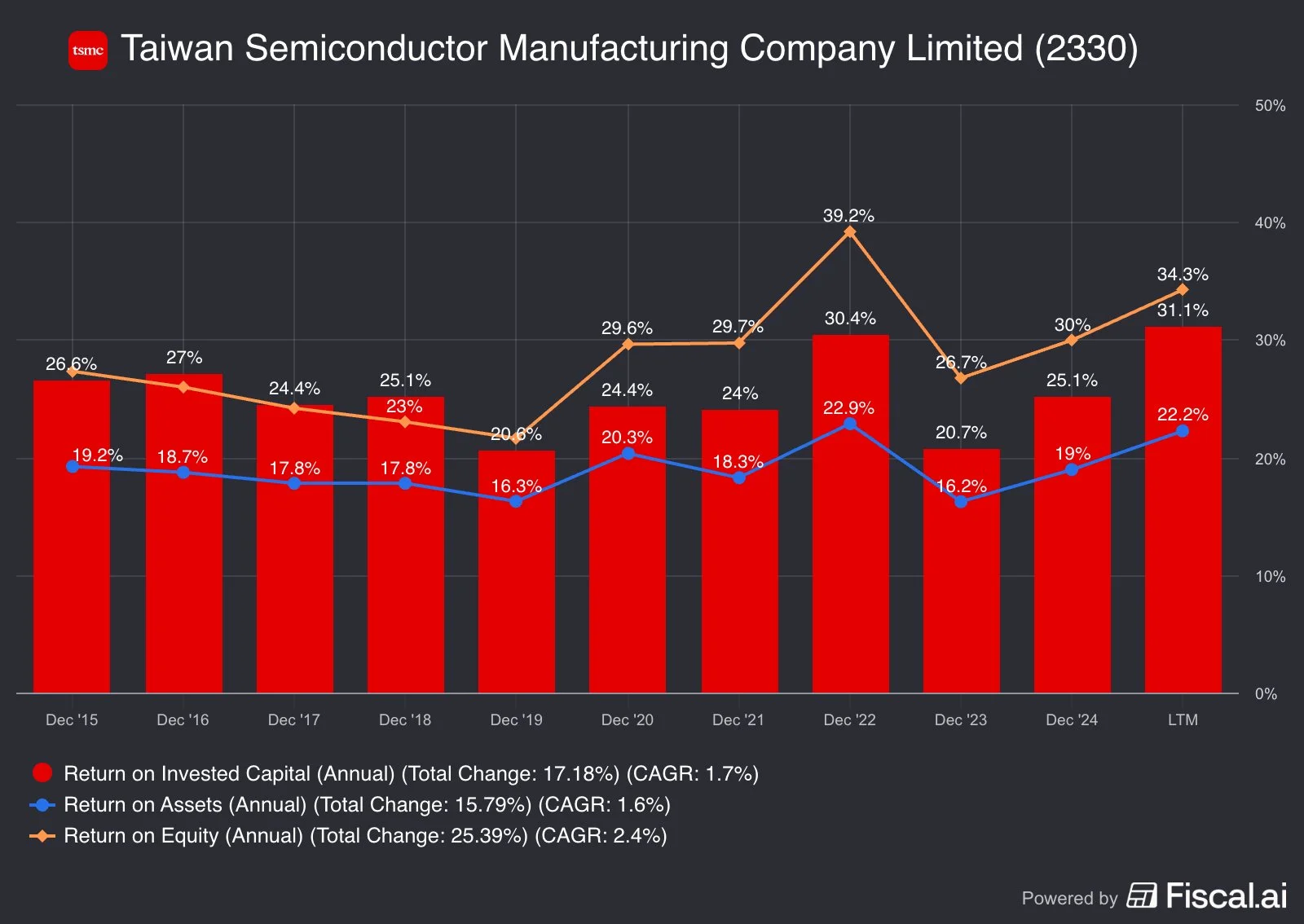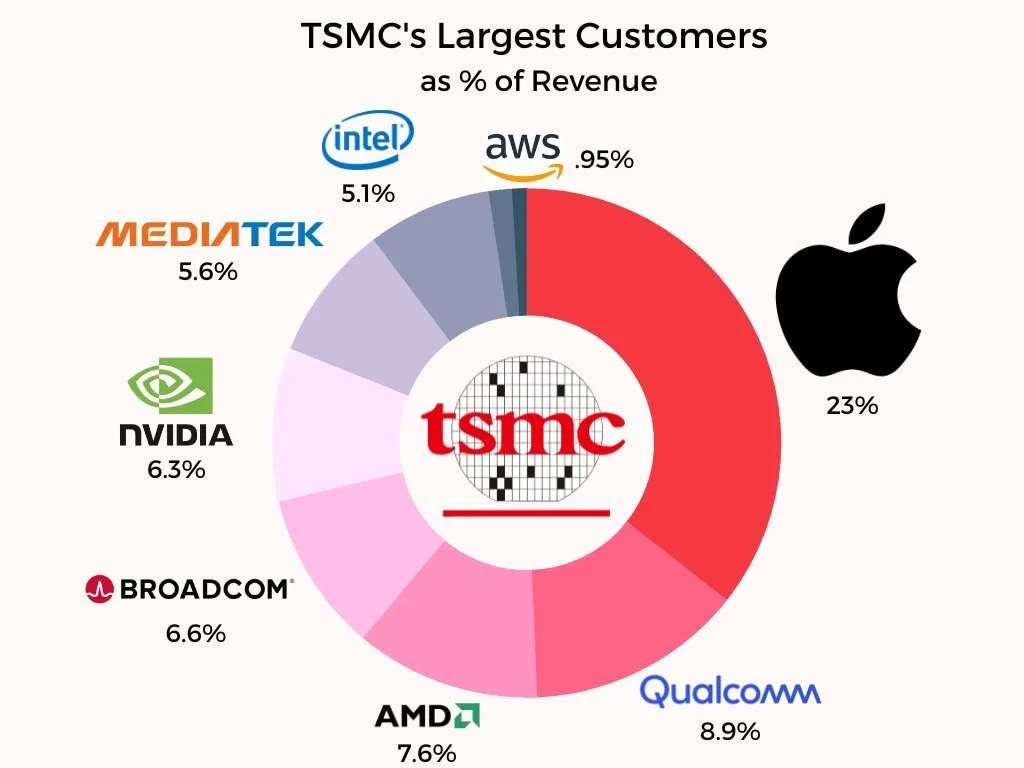TSMC: Should Long-Term Investors Buy Now?
Back in 1987, Morris Chang, a veteran chip engineer trained in the U.S., started TSMC with a bold idea: a company that makes chips for others, without competing with its customers.
That idea changed the industry — and today, TSMC is the world’s most important chipmaker, powering everything from iPhones to AI data centers.
And it's still delivering.
In 3Q25, TSMC reported $33.1B in revenue (+30% YoY) and record margins (59.5% gross, 45.7% net). Advanced chips now make up 74% of wafer sales, with AI demand pushing growth faster than ever.
Now, the company is at an inflection point — moving beyond scale to price leadership and deeper AI integration.
Why This Matters Now
AI boom = Structural growth: TSMC is the backbone of AI chips. Near-100% share in AI silicon manufacturing. AI revenue is expected to grow 50%+ CAGR through 2028.
Pricing power finally unlocked: TSMC is shifting from volume to value-based pricing, with 5–10% hikes across advanced nodes and CoWoS packaging.
Global scale, deep moat: TSMC dominates leading-edge nodes (3nm/5nm) with ~90% market share. No real alternative at high end sophisticated chips.
It controls the most critical link in the global tech supply chain — Apple, Nvidia, AMD, and even Intel rely on TSMC; there's no replacement at this scale yet.
Margins are holding strong despite global expansion — 58% gross and 43% net in Q2 2025 while ramping fabs in the US, Japan, and Germany.
Geopolitical risk only highlights its importance — Taiwan is a flashpoint, but TSMC’s position in the chip ecosystem makes it too strategic to ignore.
Next-gen nodes = more pricing power — N2 and A16 nodes launching 2025–26 will drive higher ASPs and stickier customer relationships.
The company is at an inflection point: Structural free cash flow (FCF) breakout + accelerating pricing = compounded upside.
The Business: What They Do
TSMC is the world’s largest, pure-play semiconductor foundry.
It builds chips for NVIDIA, AMD, Apple, Qualcomm, and increasingly Intel.
No internal products → never competes with its customers.
Key segments:
HPC (AI, data centers): 60%
Smartphones: 27%
Auto + IoT + DCE: 13% combined
Source: TSMC
How They Make Money
Charge per wafer produced using TSMC’s proprietary nodes (3nm, 5nm, etc.).
Packaging (CoWoS) is now a major high-margin contributor, especially for AI.
Revenue Breakdown (2024)
By Tech: 74% from 7nm or better
By Geography: 70% North America
By Customer: Top 10 = 76% of sales
Source: TSMC
Management & Alignment
C.C. Wei: CEO + Chairman since 2024. Clear mandate: scale, price, lead.
Strong governance: 70% independent board.
Skin in the game: Wei owns >6M shares; execs must hold 18x salary in stock.
Despite holding just 0.12%, management’s strategic role is crucial — e.g., Apple’s chips built by TSMC, assembled by Foxconn.
Capital Allocation Discipline
$60B+ CapEx in 2024, focused on leading-edge nodes + global fab expansion.
Investing in Taiwan, US (Arizona), Japan, Germany.
R&D = 7% of sales. Tech leadership is non-negotiable.
Dividends rising steadily. Small but growing buybacks to offset stock dilution.
📊 Strong, Steady Returns
ROIC: Held strong between 20–30%, peaking at 30.4% in 2022. Still healthy at 31.1% LTM.
ROA: Consistent at 16–19%, hitting a high of 22.2% LTM.
ROE: Climbed from 26.6% to 34.3%, peaking at 39.2% in 2022.
Even while building fabs globally, returns stayed elevated — that’s rare.
Profitability Snapshot
Despite global expansion, TSMC is defending profitability better than most companies — that proves the discipline they have in a capital-heavy business.
Gross margin climbed from 48.7% to 58.6%, and operating margin from 38.1% to 48.8%, driven by strong pricing and tight cost control.
Free cash flow as a % of net income dropped from 89.9% to 64.9%, bottoming at 34.3% in 2023 due to heavy CapEx — but signs of recovery are clear.
Competitive Moat
Tech leadership: Always first to new nodes (3nm, 2nm, A16).
Customer entanglement: Co-design, co-optimization → high switching costs.
Scale = cost edge: Massive R&D + fab scale → higher yields, lower costs.
Trust moat: Never competes. Partners deeply with customers like Apple, Nvidia.
Intel & Samsung simply can't catch up. Customers stick with what's proven.
Source:Data Gravity
Valuation & Upside
P/E ~40×
Market is pricing in strong, sustained earnings — TSMC is seen as a structural AI winner, not a cyclical chip stock.P/FCF ~26×
Despite heavy CapEx, FCF multiple remains high — market expects a rebound as investments normalize.DCF backs it up
Implied growth expectations ~20% — in line with AI demand, pricing power, and product mix shift.
TSMC is priced for execution. So far, it’s delivering. You’re buying a monopolistic, mission-critical asset and it's rarely cheap.
Market Potential
AI accelerator revenue growing at 45% CAGR.
Management guides AI to be ~20% of total revenue by 2028.
Foundry 2.0 (including advanced packaging) is a $250B+ TAM.
Semiconductor market ex-memory: $514B in 2024, MSD-HSD% CAGR to 2030.
Risks
🇨🇳 China-Taiwan conflict – Low probability, massive downside if China invade Taiwan.
🧠 AI CapEx pullback – Possible mid-term dip, long-term trend intact.
📉 Intel foundry threat – Low execution credibility, losing money, still reliant on TSMC.
📱 Huawei rebound – Risk to Apple volumes; indirect exposure.
🇺🇸 US tariffs – China tariffs help; Taiwan-specific tariffs pass to customers.
Conclusion
You’re not just buying a chip factory — you're owning the backbone of the AI era.
TSMC has unmatched scale, customer stickiness, pricing power, and optionality via AI.
TSMC is a monopoly in one of the most critical tech infrastructures of the next decade — and of course that deserves a premium.
SCC Rating: 85% | Buy
At Silvercrosscapital we built the Outlier Portfolio on one truth: a handful of stocks create nearly all long-term wealth. Apple already did it.
Our mission? Find the next Apple before Wall St. does.







